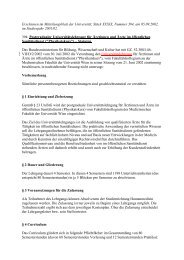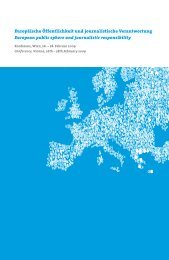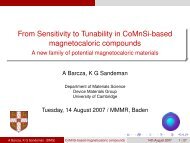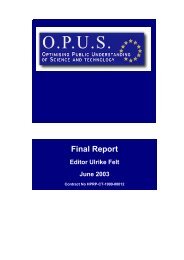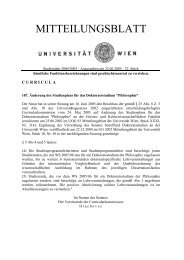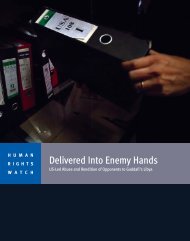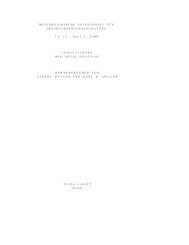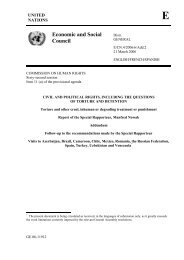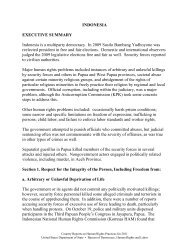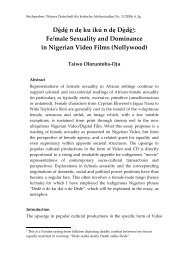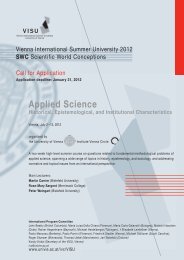(Stand: 25. Juli 2007) ANDERSON, Michael Alan ... - Universität Wien
(Stand: 25. Juli 2007) ANDERSON, Michael Alan ... - Universität Wien
(Stand: 25. Juli 2007) ANDERSON, Michael Alan ... - Universität Wien
You also want an ePaper? Increase the reach of your titles
YUMPU automatically turns print PDFs into web optimized ePapers that Google loves.
MEDIEVAL & RENAISSANCE MUSIC CONFERENCE <strong>2007</strong> – WIEN, 7.-11. AUGUST ABSTRACTS<br />
(kungliga riksarkivet) aufbewahrt und, der von Toni Schmid in den 30er Jahren angefangenen<br />
und von u.a. Gunilla Björkvall vor Kurzem fertiggestellte Katalogisierung folgend,<br />
belaufen sich auf etwa 22.500. Eine große Menge der Fragmente (und jedenfalls die für<br />
eine vernünftige Beurteilung des Repertoires brauchbarsten) besteht aus bifolia, die während<br />
der ersten 100 Jahre der Vasa Regierung als Umschläge für Rechnungsbücher benutzt<br />
worden waren.<br />
Der heutige Vortrag wird sich auf 38 Offizienfragmente der vier wichtigsten marianischen<br />
Feiertage konzentrieren, d.h.: Purificatio (Lichtmess: am 2. Februar), Annuntiatio<br />
(Verkündigung: am <strong>25.</strong> März), Assumptio (Himmelfahrt: am 15. August), Nativitas (Geburt:<br />
am 08. September). Der Grund für solch eine pointierte liturgische Begrenzung besteht<br />
darin, dass der Kultus der Jungfrau zu den weitverbreitesten und erfolgreichsten des<br />
Mittelalters zählt und die Anzahl an spezifischen Gesängen relativ sparsam ist, so dass<br />
alle lokalen Varianten, auch der Reihenfolge nach, am deutlichsten aufzutauchen erlaubt<br />
sind. Da die Handschriften, aus denen die Fragmente stammen, zu den ersten Zeugen der<br />
Verbreitung und Verwurzelung eines kirchlichen Repertoires in Skandinavien bzw.<br />
Schweden gehören, kann ihre Genese und Filiation nur Dank eines systematischen Vergleichs<br />
unter einer Auswahl Quellen deutscher, normannischer und englischer Herkunft<br />
erwiesen werden, da jene europäischen Regionen eben die sind, die die ersten kulturellen<br />
(und später religiösen) Verknüpfungen mit dem post-vikingischen Skandinavien aufstellen.<br />
� �<br />
BRAND, Benjamin (College of Music, University of North Texas)<br />
Inside the Studio of a Late-Medieval Choirmaster: John Hothby at the Cathedral of<br />
Lucca<br />
Donnerstag/Thursday, 9.8., 18.00 Uhr, MuWi, HS 1<br />
Although musical treatises of the fourteenth and fifteenth centuries show that counterpoint<br />
was central to the curriculum of late-medieval choir schools, it remains uncertain<br />
precisely how students progressed from singing strict, unmeasured discant to complex<br />
mensural polyphony. New evidence concerning the most celebrated pedagogue of the late<br />
fifteenth century, John Hothby, elucidates this critical stage in learning. As choirmaster at<br />
the cathedral of Lucca from 1467 to 1486, this Englishman trained the chaplains and choirboys<br />
of that church to sing the intricate polyphony of northern composers. His teachings<br />
find a telling witness in five exercises in mensural counterpoint added to an inventory of<br />
the sacristy (Lucca, Archivio Archivescovile, Enti religiosi soppressi, 3086) by a chaplain<br />
of the cathedral.<br />
One of only two examples of “model composition” to survive from before 1500, they<br />
newly illuminate Hothby’s program of study in Lucca and more broadly expand our<br />
knowledge of music pedagogy in the late Middle Ages and Renaissance. The Lucchese<br />
exercises witness the steadily more fluent and sophisticated elaboration of note-againstnote<br />
progressions between a cantus and tenor through imitation and diminished counterpoint.<br />
They exemplify the rules in Hothby’s pedagogical treatises and evince particular<br />
affinities with the Tractatus quarundam regularum artis musice. A contemporary Tuscan<br />
source (Florence, Biblioteca Nazionale, Palatino, 472) presents eight two- and threevoice<br />
laude in the folia directly following that text. These include Verbum caro factum est, which<br />
- 21 -




